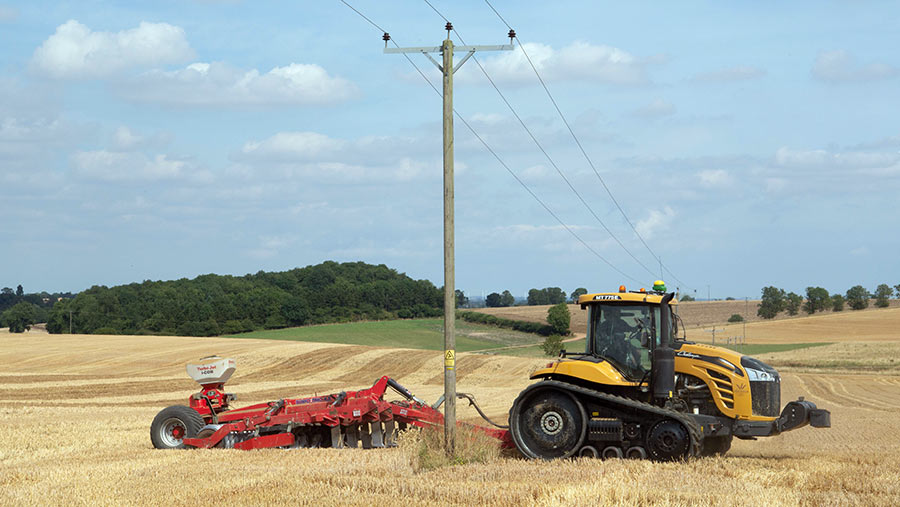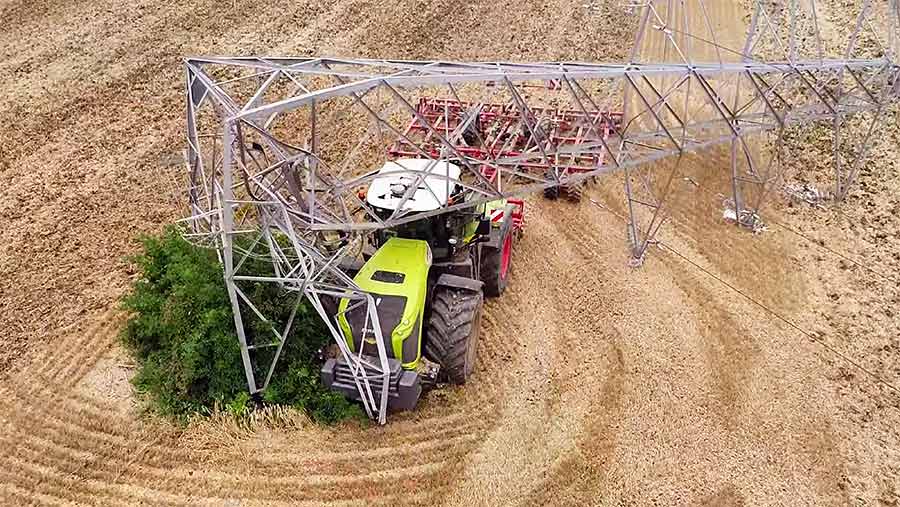How to work safely near overhead power lines on farmland
 © Tim Scrivener
© Tim Scrivener According to the Farm Safety Foundation, at least one farmworker dies each year as a result of contact with an overhead power line.
In the past five years, there were 1,140 near-misses involving machinery and overhead power lines and, every year, there are about 225 reported incidents where farm vehicles and machinery make contact with overhead lines.
As well as the potential to kill or seriously injure those involved, there are the financial costs in terms of damaged or destroyed equipment and lost time.
Even though power lines are normally visible, people are less aware of them when they are busy at work, particularly at night, so accidents do happen, says the Farm Safety Foundation (FSF).
It advises farmers to find out the heights and locations of overhead power lines crossing their land and mark these on a map, along with avoiding storing materials and crops or stacking bales under such lines.
“When buying new machinery, make sure you are aware of its maximum height and ensure there is sufficient clearance to pass safely beneath power lines on your land,” says the FSF.
“Make sure people working on your farm, including contractors, are aware of the heights of overhead power lines so that they can plan their work to reduce the risk of coming into contact with them.”
See also: Farmers warned to stay safe around power lines this harvest
Consequences
According to the Energy Networks Association, more than 85% of people never worry about getting too close to an overhead power line, despite the potentially fatal consequences.
During harvest 2017, for example, it says there were 39 “contact incidents” in just four weeks – each with the potential for the vehicle operator or someone nearby to suffer a fatal electric shock.
Such incidents typically involve tipping trailers, lorry-mounted cranes, combine harvesters and telehandlers, it says.
“Certain work should be avoided altogether within 10m of overhead power lines, such as stacking bales and potato boxes, operating telehandlers and moving irrigation pipes.”
See also: Take care when working under power lines
Tips to stay safe with electricity
Ian Crawley, SSEN’s head of safety, health and environment at network operator Scottish and Southern Electricity Networks (SSEN) points out some dangers.
These include trees and hedgerows which may have grown and could now obscure nearby lines; intense heat in the summer can cause lines to sag slightly; and working with different styles or heights of machinery may bring you closer to the lines than in previous years.
“Always take the opportunity to risk assess before any work begins – it’s a small step to take that could make all the difference,” he says.
- “Look out, Look up!” before you start work in any areas where electricity lines are present
- Risk assess and be aware of the height of machinery that will be in use near lines
- Ensure there’s plenty of clearance – remember that electricity can jump if an object comes near enough
- If you do come into contact with an overhead line or cable, stay in your cab or vehicle and try to avoid touching anything metal within it
- Call 105 immediately – this is the UK-wide single emergency number for power companies and is the quickest way to put you through to the correct network operator
- If the situation is too dangerous to stay put – for example, if the machinery is affected by fire – it’s advised that you leap out of the vehicle as high and as far as you can to avoid touching any part of the machinery or electricity network
- If you must get off, then you should jump clear, making leaping strides so that one foot is off the ground at all times until you are at least 5m away
- Do not return to the vehicle
- Keep others away from the vehicle. Touching it or even getting too close could kill them
- Never touch overhead power lines, always assume that lines are live unless the electricity company has told you they are dead
Case study: Flawborough Farms, Nottinghamshire

Tom Hawthorne
It was mid-morning on 21 August 2017 when Tom Hawthorne received a WhatsApp message from one of the tractor drivers out cultivating on Flawborough Farms.
The message was, he says, “slightly underwhelming” in that it just gave the impression he’d clipped a pylon in the middle of a 35ha field.
Mr Hawthorne, a partner in the family business, immediately headed to the scene and, as he got nearer, noticed something didn’t look right about the wires on the pylons he passed.
“When I got to the field, I saw a collapsed pylon bent over the top of the tractor roof and smoke everywhere. I immediately feared the worst,” he recalls.
The tractor driver, who had been working on auto-steer, had been looking over his shoulder and using the hydraulics to try to shake out straw that had become tangled in the cultivator.
Not looking ahead for a few seconds was all it took: the tractor hit the pylon, breaking one of its legs and causing it to topple on to the Claas Xerion.
“He’s a well-trained and experienced tractor driver who knows the field – it was just a moment’s lapse in concentration that could have happened to anybody,” says Mr Hawthorne.
“Auto-steer is brilliant, but it does allow you to concentrate on other things, which can sometimes be distracting.”

© Flawborough Farms
He arrived at the scene about 15min after the incident happened (it would have been sooner, but for a poor mobile phone signal) to find the driver upset, but unhurt.
“We can’t call it a complete near-miss because he hit the pylon, but it was the biggest near-miss ever in terms of someone not being seriously injured or killed. He was incredibly lucky,” says Mr Hawthorne.
“In a situation like this, the general advice is to stay in the cab unless it’s not safe to do so because of fire.
“Because the stubble and straw in the implement had caught fire where the wires had fallen on to it, the driver chose to get out, but he was very lucky he wasn’t electrocuted as he did so.
“We take health and safety incredibly seriously – I like to think we are in the top 1% of farms – but it’s reminded us, even more, how dangerous farming can be.
“We employ students in the summer and we now talk about the dangers of electricity as part of their health and safety induction.”
Keen to spread awareness, Mr Hawthorne posted a video of the tractor tangled in the pylon on social media – which brought praise and criticism.
“We got a bit of ribbing over it, not least because the incident left a lot of homes temporarily without electricity.
“Some farmers try to keep incidents like this quiet because they’re embarrassed, but we felt it was important to get people talking to highlight the risks.
“Machinery gets ever bigger and ever taller, and we all, as farmers, get ever busier, so even though tiredness wasn’t a factor in this case, it can contribute to accidents.”
Online advice to keep you safe
Northern Powergrid released a safety video, to help the rural community stay safe during the darker mornings and evenings.
Its key message was summed up by the acronym SHOCK:
- Safe – drive away if safe to do so
- Help – if not, stay in cab and call 105 and seek help
- Others – warn others to stay away
- Clear – if not safe to stay in cab, jump clear
- Keep away – don’t return to the vehicle
Power lines are also one of the topics mentioned in a new risk-management website launched by AXA UK.
Designed with the support of the HSE, the online tool aims to help farmers assess their own risks and identify the areas they can improve and has been created in response to HSE figures showing 33 people were killed in farming, fishing and forestry accidents in 2017-18.
